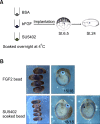Spatiotemporal regulation of fibroblast growth factor signal blocking for endoderm formation in Xenopus laevis
- PMID: 18985013
- PMCID: PMC2679358
- DOI: 10.3858/emm.2008.40.5.550
Spatiotemporal regulation of fibroblast growth factor signal blocking for endoderm formation in Xenopus laevis
Abstract
We have previously shown that the inhibition of fibroblast growth factor (FGF) signaling induced endodermal gene expression in the animal cap and caused the expansion of the endodermal mass in Xenopus embryos. However, we still do not know whether or not the alteration of FGF signaling controls embryonic cell fate, or when FGF signal blocking is required for endoderm formation in Xenopus. Here, we show that FGF signal blocking in embryonic cells causes their descendants to move into the endodermal region and to express endodermal genes. It is also interesting that blocking FGF signaling between fertilization and embryonic stage 10.5 promotes endoderm formation, but persistent FGF signaling blocking after stage 10.5 restricts endoderm formation and differentiation.
Figures



Similar articles
-
Inhibition of FGF signaling causes expansion of the endoderm in Xenopus.Biochem Biophys Res Commun. 2004 Feb 27;315(1):100-6. doi: 10.1016/j.bbrc.2004.01.019. Biochem Biophys Res Commun. 2004. PMID: 15013431
-
Specific induction of cranial placode cells from Xenopus ectoderm by modulating the levels of BMP, Wnt, and FGF signaling.Genesis. 2015 Oct;53(10):652-9. doi: 10.1002/dvg.22881. Epub 2015 Aug 24. Genesis. 2015. PMID: 26249012
-
Expression patterns of Xenopus FGF receptor-like 1/nou-darake in early Xenopus development resemble those of planarian nou-darake and Xenopus FGF8.Dev Dyn. 2004 Aug;230(4):700-7. doi: 10.1002/dvdy.20040. Dev Dyn. 2004. PMID: 15254904
-
[Function, molecular structure and gene expression of fibroblast growth factor (FGF/HBGF)].Nihon Rinsho. 1992 Aug;50(8):1893-901. Nihon Rinsho. 1992. PMID: 1433981 Review. Japanese.
-
Signaling molecules that mediate the actions of FGF.Princess Takamatsu Symp. 1994;24:243-9. Princess Takamatsu Symp. 1994. PMID: 8983079 Review.
Cited by
-
Endodermal Maternal Transcription Factors Establish Super-Enhancers during Zygotic Genome Activation.Cell Rep. 2019 Jun 4;27(10):2962-2977.e5. doi: 10.1016/j.celrep.2019.05.013. Cell Rep. 2019. PMID: 31167141 Free PMC article.
-
Ventx1.1 as a Direct Repressor of Early Neural Gene zic3 in Xenopus laevis.Mol Cells. 2018 Dec 31;41(12):1061-1071. doi: 10.14348/molcells.2018.0341. Epub 2018 Nov 26. Mol Cells. 2018. PMID: 30590909 Free PMC article.
References
-
- Amaya E, Stein PA, Musci TJ, Kirschner MW. FGF signalling in the early specification of mesoderm in Xenopus. Development. 1993;118:477–487. - PubMed
-
- Cha SW, Hwang YS, Chae JP, Lee SY, Lee HS, Daar I, Park MJ, Kim J. Inhibition of FGF signaling causes expansion of the endoderm in Xenopus. Biochem Biophys Res Commun. 2004;315:100–106. - PubMed
-
- Ciruna B, Rossant J. FGF signaling regulates mesoderm cell fate specification and morphogenetic movement at the primitive streak. Dev Cell. 2001;1:37–49. - PubMed
-
- Clements D, Friday RV, Woodland HR. Mode of action of VegT in mesoderm and endoderm formation. Development. 1999;126:4903–4911. - PubMed
Publication types
MeSH terms
Substances
LinkOut - more resources
Full Text Sources
Miscellaneous
